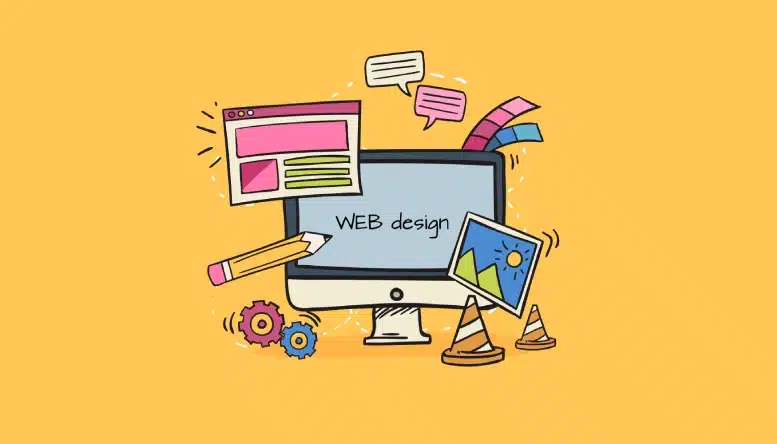Web Design London Ontario with Search Engine Optimization and Mobile Optimization
How to Properly Incorporate Looks and Capability in Website Design
When creating an internet site, you require to strike an equilibrium in between visual appeals and performance. It's not practically looking excellent; your layout should also serve a function and guide individuals successfully. By concentrating on simpleness and user-friendly navigating, you can produce an interesting experience. Yet what components absolutely boost use while keeping aesthetic charm? Let's check out the essential principles that can result in a harmonious mix of elegance and feature.
Recognizing the Relevance of Aesthetics and Functionality
Understanding the equilibrium in between aesthetic appeals and performance is important for developing an efficient user experience when you make a site. A visually enticing website grabs attention, yet it's the functionality that maintains individuals engaged. Visitors will swiftly shed rate of interest and leave.Consider your target audience and what draws them in if your site looks fantastic yet is tough to browse. You wish to develop a layout that shows your brand name while guaranteeing convenience of use. Structured layouts, instinctive navigation, and clear telephone calls to action can improve both visual appeals and capability.

Concepts of Efficient Web Layout
To create an efficient internet style, you need to abide by numerous crucial principles that boost both individual experience and aesthetic charm. Focus on simplicity; a tidy format assists users browse easily. Make use of a consistent shade scheme and typography to keep coherence throughout your website. This promotes knowledge and trust.Next, ensure your design is responsive. Customers access web sites on various tools, so your design ought to adjust flawlessly. Pay focus to aesthetic hierarchy; emphasize vital elements with shade, positioning, or size to guide individuals' focus.Finally, incorporate ample white area. It stops mess and makes web content more digestible. Bear in mind, efficient website design equilibriums aesthetic appeals and capability, so every layout selection should serve a purpose. By complying with these principles, you'll produce a site that's not only visually attractive however likewise easy to use, eventually maintaining site visitors engaged and motivating them to return.
Prioritizing Individual Experience
When prioritizing user experience, you'll intend to start by understanding what your users truly need. Streamlining navigating layout can make a massive distinction in just how quickly they discover what they're searching for. Boosting aesthetic power structure helps lead their focus to the most crucial aspects on your site.
Understanding User Demands
Recognizing individual needs is essential for developing an engaging web experience that keeps visitors returning. To achieve this, you should recognize the goals and choices of your target audience. Begin by conducting individual study, like surveys or meetings, to gather understandings on what users value most. When interacting with similar internet sites, pay focus to their discomfort factors and obstacles. This information allows you to tailor your style, ensuring performance straightens with user expectations. Furthermore, take into consideration developing user personalities that stand for different sections of your target market, assisting you picture their demands throughout the design process. When you prioritize comprehending individual demands, you develop a website that not only looks terrific yet likewise supplies a smooth, delightful experience that fosters loyalty.
Simplifying Navigating Design

Enhancing Visual Hierarchy
A strong aesthetic pecking order is vital in directing users via your web site and guaranteeing they involve with key web content. To attain this, utilize spacing, size, and color strategically. Make vital aspects like headings larger and bolder than body message, attracting attention instantly. Make use of contrasting shades to highlight phone call to action, urging clicks. Furthermore, employ adequate white space to different sections, making material digestible and inviting.Consider the circulation of info; arrange aspects logically, leading customers' eyes from one point to the following. Use visual hints, like arrowheads or lines, to direct focus. By prioritizing aesthetic power structure, you improve user experience and boost the possibility of conversions, guaranteeing your site is both cosmetically pleasing and functionally effective.
Shade Theory and Its Influence On Use
While selecting the appropriate colors for your web site may look like a small detail, it considerably affects usability and user experience. Shade affects how individuals regard info and can improve or impede navigation. Contrasting shades can help essential aspects stand out, making it much easier for site visitors to locate what they need.Additionally, consider the psychology of colors: blue typically motivates trust fund, while red creates urgency. Recognizing your target audience can direct your shade choices, assuring they reverberate well.Moreover, constant color pattern aid build brand click to find out more identification, making your internet site a lot more remarkable. Be careful-- too many shades can overwhelm users. Adhere to a restricted scheme that enhances your material and maintains clarity.Incorporating access is also important; confirm your color combinations get along for those with visual problems. By attentively applying color theory, you'll enhance use and produce a much more engaging customer experience.
Typography: Harmonizing Style and Readability
Color options established the phase for your web site, however typography plays a similarly vital role in enhancing customer experience. You want your message to connect clearly while also showing your brand name's individuality. Start by choosing typefaces that are not just appealing but likewise legible. Sans-serif typefaces usually work well for electronic screens, as they're simpler to review at numerous sizes.Maintain a power structure by utilizing various font style dimensions and weights; this overviews customers with your content easily. Consider line spacing and letter spacing; as well tight can irritate visitors, while also loosened can disrupt the flow. Restriction your font options to 2 or three to maintain the design cohesive.Finally, constantly test your typography across various devices and web browsers. What looks excellent on one display might not on an additional. Stabilizing design with readability warranties that your message reverberates, maintaining your target market engaged and educated.
Receptive Layout: Making Appearances Function on All Devices
To ensure your internet site looks terrific on any kind of device, you'll require to embrace responsive style principles. This approach warranties your website adapts to different display sizes, offering an excellent user experience. Start by utilizing liquid grids and flexible images that scale perfectly. As opposed to dealt with measurements, opt for portions and loved one devices, allowing your layout to adjust dynamically.Next, carry out media queries in your CSS. These let you apply different styles based on device qualities, like display size. In this manner, you can preserve aesthetic appeal while assuring functionality.Don' t ignore touch targets; ensure buttons and links are easy to touch on smaller sized displays. Focus on necessary web content, so customers can conveniently navigate your website no matter of their tool. By concentrating on these elements, you'll create an engaging, visually appealing experience that find out here fulfills the demands of all individuals, whether they're on a desktop, smart device, or tablet computer .
Conducting Use Screening for Continual Improvement
To boost your website design, you require to set clear functionality objectives that line up with user needs. By conducting customer tests, you can collect beneficial comments on how actual people interact with your website. Evaluating these outcomes will help you make educated improvements and develop a much more reliable individual experience.
Specifying Functionality Goals
While aesthetic appeals can attract individuals in, specifying functionality objectives is important for ensuring their experience stays seamless and gratifying. Beginning by determining what you desire users to attain on your site (website design london Ontario). Consider their requirements, jobs, and behaviors. Are they searching for details, purchasing, or authorizing up for an e-newsletter? Establish clear criteria to determine success, like job completion prices or time on task. Prioritize user-friendly navigating, easily accessible web content, and receptive design to enhance functionality. On a regular basis review these objectives as customer expectations develop. By defining use objectives, you create a framework visit their website for examining and boosting your internet site's performance. This concentrate on use not only improves individual contentment but also enhances the overall efficiency of your design
Performing User Tests
Conducting individual tests is vital for fine-tuning your web site and ensuring it satisfies your audience's requirements. Begin by determining your target individuals and producing a test strategy that describes your goals. Utilize a mix of quantitative and qualitative methods, such as surveys, meetings, and task-based monitorings, to collect thorough feedback. Invite participants to browse your website while you observe their interactions and note any kind of difficulties they encounter. Motivate open dialogue to record their ideas and feelings about the design and capability. Keep sessions brief and concentrated, ensuring you cover key locations without overwhelming users. Make sure to document all searchings for, as this information will certainly be vital for making educated layout decisions that enhance both appearances and functionality.
Analyzing Examination Results
Exactly how can you effectively assess the results of your use tests to drive continual improvement? Beginning by categorizing comments into typical themes. Try to find patterns in user habits that highlight pain points or areas for improvement. Usage quantitative information, like task completion prices and time on task, to determine usability objectively. Do not forget to consider qualitative understandings from user comments; they typically disclose underlying issues that numbers can't reveal. Focus on the most impactful searchings for and develop actionable products for your layout group. Keep in mind, it has to do with repeating-- execute modifications, after that examination again. This cycle of testing, examining, and refining aids you balance aesthetic appeals and capability, guaranteeing your site satisfies individual demands effectively while preserving aesthetic allure.
Regularly Asked Questions
How Do I Select the Right Shade Scheme for My Internet site?
To pick the right shade scheme for your website, consider your brand name's personality, target audience, and emotional impact (website design london Ontario). Use color psychology, create harmony, and guarantee readability. Test combinations to see what resonates best with visitors
What Tools Can Help With Web Design Looks and Performance?
You can utilize devices like Adobe XD, Figma, and Map out to enhance your website design's aesthetics and capability. These systems use instinctive user interfaces, partnership functions, and pre-made themes to improve your creative process and boost your layouts.
Exactly How Can I Incorporate Animations Without Compromising Performance?
To integrate animations without compromising functionality, prioritize subtle effects that improve individual experience. Use CSS computer animations for smoother interactions, assurance fast tons times, and test on numerous gadgets to maintain efficiency while adding aesthetic charm.
What Prevail Blunders to Prevent in Website Design Aesthetics?
When creating, avoid cluttered layouts, bad color choices, and irregular fonts. Do not neglect mobile responsiveness, as it can estrange individuals. Confirm your style aligns with your brand name, creating a smooth experience that involves visitors effectively.
Exactly how Frequently Should I Update My Internet site's Design for Optimum Appearances?
You need to upgrade your website's layout every 1-2 years to stay on par with trends and maintain optimal visual appeals. Routinely renewing visuals assists engage guarantees and visitors your website continues to be user-friendly and attractive. When you develop an internet site, recognizing the balance between appearances and functionality is necessary for developing a reliable customer experience. To produce an effective internet layout, you need to adhere to a number of vital concepts that enhance both user experience and visual charm. Customers access sites on different gadgets, so your style needs to adjust seamlessly. When prioritizing individual experience, you'll want to begin by comprehending what your individuals truly need. Begin by carrying out individual research, like meetings or studies, to collect insights on what customers value most.